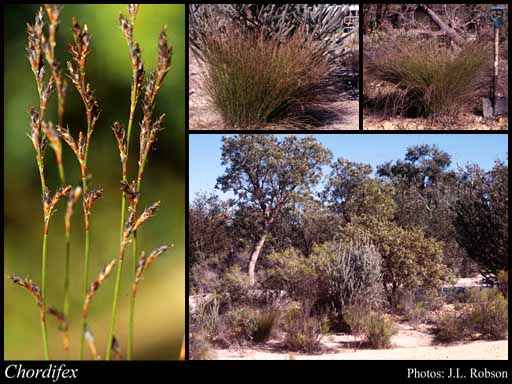- Reference
- Telopea 7:356 (1998)
- Name Status
- Current

Scientific Description
Family Restionaceae.
Habit and leaf form. Herbs (the base pubescent); evergreen. Switch-plants; with the principal photosynthesizing function transferred to stems (culms). Leaves well developed, or much reduced (the blade being much reduced or absent). Perennial. Young stems cylindrical (erect or flexuose, striate, the lowest internode often elongated and slender); not breaking easily at the nodes. Stem internodes solid, or hollow. Rhizomatous. Leaves alternate; distichous, or spiral; leathery, or membranous; sessile; sheathing (and more or less reduced to the sheaths). Leaf sheaths with free margins (persistent, appressed or lax). Leaves simple; with a persistent basal meristem, and basipetal development. Vegetative anatomy. Plants with silica bodies. Leaf anatomy. Leaf blade epidermis conspicuously differentiated into ‘long’ and ‘short’ cells, or without differentiation into ‘long’ and ‘short’ cells. Guard-cells not ‘grass type’, or ‘grass type’. Stem anatomy. Secondary thickening absent.
Reproductive type, pollination. Fertile flowers functionally male, or functionally female. Unisexual flowers present. Plants dioecious. Female flowers with staminodes (1–3), or without staminodes. Male flowers with pistillodes, or without pistillodes. Floral nectaries absent (nectaries absent). Anemophilous.
Inflorescence and flower features. Flowers aggregated in ‘inflorescences’; in ‘spikelets’. Inflorescences scapiflorous, or not scapiflorous; terminal, or axillary; male and female inflorescences similar, the flowers in erect spikelets (except males pendulous in C. microcodon), terminal or several clustered in upper axils or many in a slender much-branched inflorescence; spikelets with several or many sterile lower glumes. Flowers bracteate; bracteolate, or ebracteolate; cyclic. Perigone tube absent. Perianth of ‘tepals’; members 5, or 6; 2 -whorled; isomerous, or anisomerous; sepaloid. Fertile stamens present, or absent (when female). Androecium 3. Androecial members free of the perianth; free of one another; 1 -whorled. Androecium exclusively of fertile stamens. Stamens 3; becoming exserted, or remaining included (in C. microcodon); oppositiperianthial (opposite the inner perianth members). Anthers dorsifixed; versatile, or non-versatile; dehiscing via longitudinal slits; introrse, or latrorse; bisporangiate, or tetrasporangiate; appendaged, or unappendaged. Pollen shed as single grains. Fertile gynoecium present, or absent (male flowers). Gynoecium 1–3 carpelled. The pistil 1 celled, or 2 celled. Carpels isomerous with the perianth, or reduced in number relative to the perianth. Gynoecium syncarpous; synovarious, or synstylovarious; superior. Ovary unilocular, or plurilocular; 2 locular (usually), or 1 locular (in C. leucoblepharus and usually in C. sphacelatus); sessile to stipitate. Gynoecium stylate. Styles 2 (usually), or 1 (in C. leucoblepharus and usually in C. sphacelatus); when 2, partially joined. Placentation when plurilocular, axile to apical. Ovules in the single cavity (when unilocular) 1; (when plurilocular) 1 per locule; funicled, or sessile; pendulous; non-arillate; orthotropous.
Fruit and seed features. Fruit non-fleshy; dehiscent; a capsule (firm-walled). Capsules loculicidal. Fruit 1–2 seeded. Seeds copiously endospermic. Embryo weakly differentiated. Seedling. Hypocotyl internode absent. Mesocotyl absent. Seedling collar not conspicuous. Cotyledon hyperphyll elongated; assimilatory; more or less circular in t.s. Coleoptile absent. Seedling cataphylls absent. First leaf centric. Primary root ephemeral.
Additional characters Perianth of male flowers of ‘tepals’; 5, or 6 (tepals glabrous or adaxially pubescent, 2 outer tepals keeled). Perianth of female flowers of ‘tepals’; 5, or 6 (mostly similar to males). Stems glabrous, or pubescent (on lowest internode only); simple, or branched; not dimorphic. Male spikelets several-flowered to many-flowered. Female spikelets several-flowered to many-flowered. Caespitose, or not caespitose. Spikelets less than 10 mm long. Female spikelets compact, the glumes overlapping. Testa striate with longitudinal lines of strongly convex cells, separated by lines of flat cells.